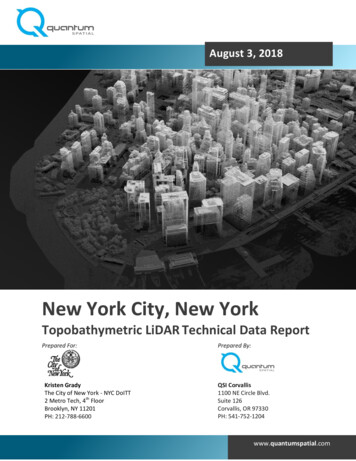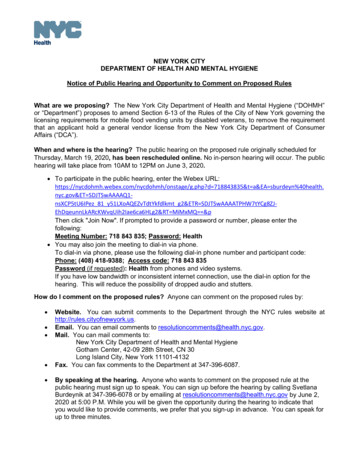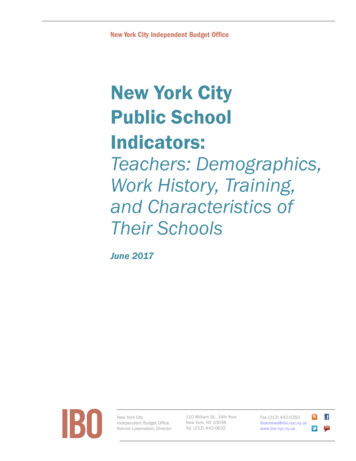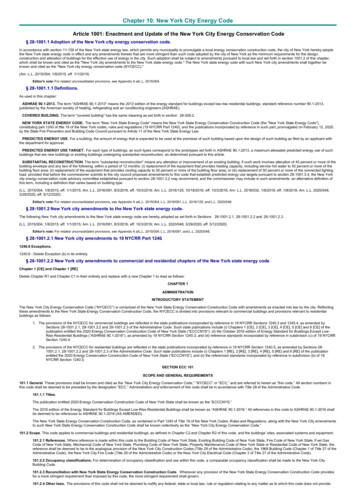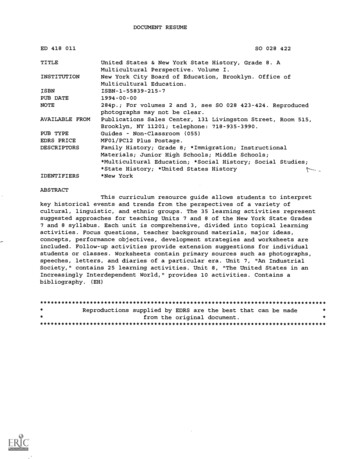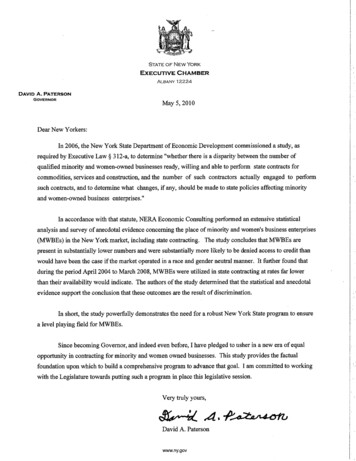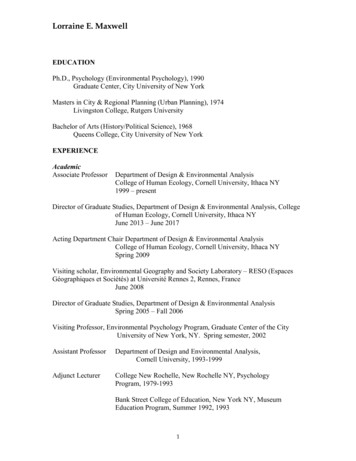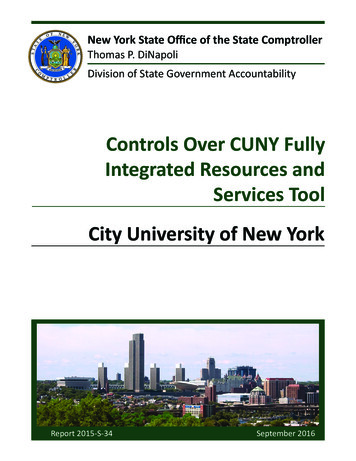
Transcription
New York State Office of the State ComptrollerThomas P. DiNapoliDivision of State Government AccountabilityControls Over CUNY FullyIntegrated Resources andServices ToolCity University of New YorkReport 2015-S-34September 2016
2015-S-34Executive SummaryPurposeTo determine whether the City University of New York (CUNY) adequately controls access tothe CUNY Fully Integrated Resources and Services Tool system (CUNYfirst) and whether CUNYadequately measured if users’ needs were met. The audit covers the period January 1, 2013through October 23, 2015.BackgroundCUNYfirst, which replaced CUNY’s Financial Management, Human Capital Management, andCampus Solutions applications, is an Enterprise Resource Program. The objective of CUNYfirst wasto replace CUNY’s legacy systems with an integrated and flexible state-of-the-art solution. Duringits early phases, CUNYfirst implementation was expected to be complete by 2012. By October 29,2015, 20 campuses had at least part of the system implemented, and at that time, the projecteddate for project completion was October 2016. As of September 30, 2015, CUNY reported thecost to develop and implement CUNYfirst was 249.75 million.CUNYfirst, like many large computer systems, uses role-based access. Roles are created for thevarious functions at CUNY, such as the Admissions Office or Registrar. These roles give individualspermission to perform certain operations that are assigned to these functions. For example, inthe Admissions Office one of the roles would be to allow staff to update academic test data for astudent. Students and staff are assigned particular roles, and thereby acquire the rights to accesscertain CUNYfirst applications.As of April 23, 2015, CUNY reported CUNYfirst had approximately 1.27 million accounts (1.15million students and 123,000 employees). The student accounts include both former and currentstudents. The employee category includes faculty, administrative, and student employees whetheractive, inactive, or retired.Key FindingsWe concluded that CUNY’s processes and controls did not adequately restrict CUNYfirst users’access to ensure that individuals only had appropriate roles assigned. For example, we determinedthat: CUNY’s Central Office (CUNY Central) granted 60 roles to Application Security Liaisons, or ASLs(information technology personnel who grant access to CUNYfirst at the campuses) withoutadequate justification. The business needs for the ASLs to have the roles in question wereunclear. In addition, there were 27 roles that were removed from employees who had leftCUNY, but not until 3 to 32 months after their departure. A student had access to CUNYfirst Financial and Supply Chain Management (FSCM) module, abusiness application that students normally cannot access. Such access requires an approvedaccess form; however, no form was on file for this student. The student, who was not an employeeof the campus and had no business need for FSCM, could access FSCM data and accessed theFSCM application on three occasions. We also examined 244 employees’ accounts, all of whichDivision of State Government Accountability1
2015-S-34required approved access forms. We identified 170 employees who had 990 unauthorized roles,including 83 that were designated by CUNY as “sensitive.” For example, certain users’ rolesallowed them to change personal information for any student, and this role was not restrictedto the campus where the ASL worked. Multiple individuals appeared to have roles for which they had no business purpose. Forexample, 22 employees outside of financial aid could apply for student loans for individualsother than themselves. CUNY officials stated that while it may appear that these functions (suchas applying for a loan) could be executed, they most likely could not. However, they providedno basis to support their statement. Also, a student employee had unauthorized grade changecapability. For the period January through May 2015, this student employee changed grades127 times for other students, but did not change her own grades. In 37 of 49 sampled cases, a user delegated a function to another person, but did not indicatean end date for the delegation. Without specifying an end date, the individual with delegatedrights retains access indefinitely, increasing the risk of improper use.Also, CUNY performed a survey of CUNYfirst users and potential users in November 2012 thatdid not include any students. Since then, another 11 campuses have implemented CUNYfirst;however, no survey or other process to obtain feedback from the users has been performed.Our audit also identified certain findings and made a corresponding recommendation pertainingto the data integrity of particular CUNYfirst functions. We presented these findings andrecommendation in detail to CUNY officials during the course of the audit’s fieldwork. However,to help preserve security over these functions, we did not detail the findings and recommendationin this report.Key Recommendations Require CUNY Central and the campuses to prepare and maintain documentation of all approvalsof roles that are assigned or removed in CUNYfirst. Require CUNY Central, in addition to the attestations, to actively monitor all user access withinCUNYfirst. Periodically review and adjust the user access roles in the system to meet the actual needs ofthe individuals identified in our audit and system-wide. Create a policy requiring a formal end and/or review date for all role delegations in CUNYfirst. Periodically survey users from all CUNYfirst user groups to measure whether their needs arebeing met.Other Related Audits/Reports of InterestCity University of New York – York College: Time and Attendance Practices for Public Safety Staff(2013-S-65)City University of New York – School of Professional Studies: Controls Over Bank Accounts (2014S-78)Division of State Government Accountability2
2015-S-34State of New YorkOffice of the State ComptrollerDivision of State Government AccountabilitySeptember 2, 2016James B. MillikenChancellorCity University of New York205 East 42nd StreetNew York, NY 10017Dear Chancellor Milliken:The Office of the State Comptroller is committed to helping State agencies, public authorities,and local government agencies manage their resources efficiently and effectively. By so doing, itprovides accountability for tax dollars spent to support government operations. The Comptrolleroversees the fiscal affairs of State agencies, public authorities, and local government agencies, aswell as their compliance with relevant statutes and their observance of good business practices.This fiscal oversight is accomplished, in part, through our audits, which identify opportunities forimproving operations. Audits can also identify strategies for reducing costs and strengtheningcontrols that are intended to safeguard assets.Following is a report of our audit of the City University of New York entitled Controls Over CUNYFully Integrated Resources and Services Tool. This audit was performed pursuant to the StateComptroller’s authority under Article V, Section 1 of the State Constitution and Article II, Section8 of the State Finance Law.This audit’s results and recommendations are resources for you to use in effectively managingyour operations and in meeting the expectations of taxpayers. If you have any questions aboutthis report, please feel free to contact us.Respectfully submitted,Office of the State ComptrollerDivision of State Government AccountabilityDivision of State Government Accountability3
2015-S-34Table of ContentsBackground5Audit Findings and Recommendations7General Access7Recommendations10Self-Assigned Access10Recommendation11Delegated Access11Recommendations11Survey of User Needs and Opinions11Recommendation12Audit Scope and Methodology12Authority13Reporting Requirements13Contributors to This Report14Agency Comments15State Comptroller’s Comments22State Government Accountability Contact Information:Audit Director: Carmen MaldonadoPhone: (212) 417-5200Email: ss:Office of the State ComptrollerDivision of State Government Accountability110 State Street, 11th FloorAlbany, NY 12236This report is also available on our website at: www.osc.state.ny.usDivision of State Government Accountability4
2015-S-34BackgroundThe City University of New York (CUNY) began in 1847 with the founding of the Free Academyby Townsend Harris. Over the decades, CUNY became a 24-campus university comprised of11 senior colleges, seven community colleges, the Macaulay Honors College, and five graduateand professional schools, located throughout New York City’s five boroughs. CUNY, the nation’slargest urban public university, offers more than 1,400 academic programs, 200 majors leading toassociate and baccalaureate degrees, and 800 graduate degree programs.Although CUNY is considered a single integrated system, its legacy information technologysystems were not integrated, and thus, these systems did not lend themselves to streamliningand standardization of business processes, such as Human Resources. Consequently, CUNYofficials concluded that they needed to replace CUNY’s financial, human resources, and studentadministration systems with an integrated and flexible state-of-the-art solution. According toCUNY’s June 2006 Board minutes, CUNY decided to implement an Enterprise Resource Programsystem with the hope it would result in “maximizing computer functionality and access for studentsand prospective students, streamlining administrative applications throughout the Universityand effectuating cross-campus compatibility in computer hardware, software, applications andconnectivity.” At that time, CUNY sought to replace the “obsolete and homegrown systems withstate-of-the-art functionality, an enterprise planning resource software solution.” The newsystem was named the CUNY Fully Integrated Resources and Services Tool (or CUNYfirst).CUNY selected an end-to-end (the supplier of an application or a system provides all of thehardware, software, and resources and no other supplier is needed) higher education solutionfrom Oracle, which included Oracle’s PeopleSoft Enterprise Financial Management, HumanCapital Management, and Campus Solutions applications, as well as Oracle Database. Oracle alsoprovided certain consulting and hosting services.The CUNYfirst system is made up of three modules, which perform distinct functions, detailed asfollows: The Financial and Supply Chain Management module includes General Ledger,Procurement, Asset Management, and Budget and Planning functions; The Human Capital Management module includes Basic HR, Recruitment, Work StudyPayroll, Employee Payroll, and Faculty Workload functions; and The Campus Solutions module includes Bursar, Admissions, Registrar and Financial Aid,Graduate Office, and Faculty Workload functions.During its early phases, CUNYfirst implementation was expected to be complete by 2012. ByOctober 29, 2015, 20 campuses had at least one module of the system implemented, and at thattime, the projected date for project completion was October 2016. As of September 30, 2015,CUNY reported the cost to develop and implement CUNYfirst was 249.75 million.CUNY Central’s Office of Computing and Information Services (CIS) is responsible for providingDivision of State Government Accountability5
2015-S-34central support for CUNY’s information technology and telecommunication needs. One of the keyroles of CIS is to lead the development of CUNYfirst. Access security for CUNYfirst is maintainedby the CIS’s Information Security Department, which is headed by the Chief Information SecurityOfficer (CISO). Each campus also has an IT Security Manager, who oversees local efforts toprotect computing and information assets. Application Security Liaisons (ASLs) are the custodiansof access to CUNYfirst. At the time of our audit, there were 89 ASLs designated at 22 CUNYcampuses. CUNY’s Central Office (CUNY Central) also has an ASL who, in addition to CUNYfirstcustodial duties, handles highly sensitive access matters CUNY-wide. The ASLs are chosen by thecampus Chief Information Officers and must be full-time employees.There were approximately 1.27 million CUNYfirst accounts as of April 23, 2015 (1.15 millionstudents and 123,000 employees). The student accounts include both former and currentstudents. The employee categories include faculty, administrative, and student employees, whowere active, inactive, or retired.Division of State Government Accountability6
2015-S-34Audit Findings and RecommendationsCUNY has policies and procedures in place for granting access to CUNYfirst once a school goeslive in the system. However, we determined that CUNY Central and the campuses did notalways comply with the requirements to ensure that only persons requiring particular roleswere authorized for those roles. In addition, CUNY’s monitoring of users’ access and roles wasinadequate. Also, CUNY performed a survey of CUNYfirst users and potential users in November2012 that did not include any students, the largest group of users. Since then, another 11campuses have implemented CUNYfirst, but no survey or other process to obtain user feedbackhas been performed. We recommend that CUNY improve its controls over access by enforcingdocumentation requirements and improving monitoring of access controls. In addition, CUNYshould periodically survey all user groups to measure whether users’ needs are being met.General AccessOversight and Monitoring by CUNY CentralCUNYfirst, like many large computer systems, provides users with role-based access. Roles arecreated for the various functions at CUNY, such as the Admissions Office or Registrar. In CUNY’scase, these roles would give individuals permission to perform certain operations that aretraditionally assigned to these functions. For example, in the Admissions Office, one of the rolesallows staff to update students’ academic test data. Students or employees (or other systemusers) are assigned particular roles, and through these assignments, acquire the rights to performparticular functions.During roll-out of CUNYfirst to the campuses, mass uploads of credentials for employees andstudents were performed by CUNY Central. In addition, CUNY Central grants and removes accessto ASLs at each campus and performs a periodic clean-up of access permissions. We revieweddocumentation for 124 of these roles and determined that it was insufficient for 104 (84 percent)of them. Officials explained that 60 of these roles were assigned when certain schools went“live” with CUNYfirst. However, to support these actions, CUNY merely provided a list of nameswith some limited cryptic comments. There were no contemporaneous documents to supportthe need for these individuals to be assigned these particular roles. Further, 27 of the 104 rolesrepresented access for employees who had previously left CUNY employment. While access tothese roles (or applications) was eventually removed, it was often not done in a timely manner.We determined that the roles were removed from 3 to 32 months after their departure.After roll-out, CUNY Central monitors campus activity through an annual control self-assessmentreview (referred to as an attestation). A control self-assessment is a process where staff in a businessunit attest to the controls in place within their unit. CUNY commonly uses control self-assessmentswhen deficiencies are detected in critical controls at the campuses, and CUNY Central requirescorrective action plans to remediate the deficiencies and provide for follow-up. For example,as part of the Analysis and Testing of Controls process, each campus must review certain users’access roles to ensure a separation of duties between the procurement and accounts payableDivision of State Government Accountability7
2015-S-34functions. Separation of duties is one of the most important features of an internal control planand is critical to decreasing fraud as well as detecting and correcting innocent errors. When wereviewed the attestations received by CUNY Central for spring 2015, we identified 47 individualswho had incompatible roles in the procurement and accounts payable functions. However, therewas no evidence that CUNY Central followed up to determine if corrective actions were taken orcompensating controls were implemented.Role Access and Sufficiency of ApprovalsStudent CUNYfirst access is automatically provisioned and made available when a student firstsigns in to his/her account. For employees, access can be granted in two ways: by completinga user access form for individuals or bulk load requests of six or more staff; and through CUNYCentral for mass changes. Both students and employees have standard access roles in the system.For example, one of the initial access roles provides self-service capabilities for both groups. Thisallows them to edit limited information in their personal profile. Students are normally providedtwo base roles, while employees are provided four and faculty five base roles.CUNY’s Guidelines for Requesting CUNYfirst Application Security Access state that employees(including students who are employed on campus) requiring additional access to perform theirjobs must submit a completed access form, with the necessary approvals. An appropriatelyapproved form is signed by an employee, supervisor, and the Subject Matter Experts (SMEs) ineach department. The form is then sent to the help desk at the campus or the CIS Service Deskat CUNY Central. The ASL processes access for all completed, approved, and logged forms. Formsthat do not have the appropriate approvals will not be processed.During our audit survey, we selected an initial judgmental sample of 23 accounts. We found that14 of 23 users sampled were provided access despite the lack of required approval signatures.One of the 14 users was a student account with more than the standard student access, whichtherefore required an approved access form. However, no form was on file for this student. Thisstudent, who was not an employee of the campus and had no need for the Financial and SupplyChain Module (FSCM) data, could access FSCM data and accessed the FSCM application on threeoccasions. Further, this student was granted rights to change financial data, which includedcertain confidential data. FSCM access should be restricted to specific financial managementemployees and is not normally assigned to students. In response to our preliminary findings,CUNY officials told us that CUNY terminated this student’s FSCM access.Based on our survey results we expanded our testing and selected a statistical sample of 306accounts out of the population of 1.27 million accounts to test CUNYfirst access at 22 CUNYcampuses. Due to the high proportion of students to employees, this sample was predominatelystudents. We therefore selected an additional random sample of 217 employees. In total, wetested 279 student accounts and 244 employee accounts.We determined that 126 (51.6 percent) of the 244 employee accounts were not properly approved.The 126 accounts had 192 forms that lacked certain required sign-offs, while two accounts hadno form on file whatsoever. Moreover, ten of the forms were signed and approved by the sameDivision of State Government Accountability8
2015-S-34employee. Of the 126 employee accounts that lacked proper approvals, 119 accounts had morethan standard CUNYfirst access as well, including the two employees with no approval forms.Altogether, we found 990 roles that were not properly authorized, and 83 of these were deemed“sensitive” by CUNY. Examples of these roles included the ability to change personal informationfor any student and the ability to access information at campuses other than the campus at whichthe ASL worked.In response to our preliminary findings, CUNY informed us that all Campus ASLs will be directedto ensure that requirements for access are enforced. In addition, CUNY campuses rescindedaccess for two individuals, provided additional forms that were not located during our visits,and prepared forms for the roles assigned to six of the selected employees. Of the 279 studentaccounts we reviewed, none of them had more than the standard CUNYfirst access roles.Access FunctionalityThe primary users of the Campus Solutions module are the Bursar, Admissions, Registrar, FinancialAid, and Information Technology departments. Collectively, the heads of these departments arecalled the “BARFIT” group. During our meetings with the university BARFIT members, we wereinformed that there are instances where individuals in one group may need “read only” access toview information from another group, with no need to change the other group’s data.However, during our campus visits, we found that 25 of 100 individuals we observed had accessthat appeared to exceed their business needs. For example, 22 employees outside of financialaid had the ability to apply for student loans for individuals other than themselves. CUNY officialsstated that while it may appear that these functions could be executed, they most likely couldnot. However, officials provided no documented evidence to support their belief.Also, we found one student employee who had unauthorized grade change ability at the schoolthe student attended. CUNY’s policies do not allow students or part-time employees to accessnon-public information, such as grades or personally identifiable information, unless an approvedwaiver is in effect. However, we determined that a student, who was a part-time employee inthe Registrar’s Office, had the ability to change grades. According to the Registrar, this studentemployee should not have had access to the grade change function. A grade change report for theperiod January through May 2015 revealed that this employee changed grades 127 times for otherstudents; however, she did not change her own grades. In response to our preliminary finding,the college modified the profile for this student to eliminate grade change access. However, evenif allowed by the waiver process, we question grade change authority being granted to studentsdue to the potential risk it presents.Our audit also identified certain findings and made a corresponding recommendation pertainingto the data integrity of particular CUNYfirst functions. We presented these findings andrecommendation in detail to CUNY officials during the course of the audit’s fieldwork. However,to help preserve security over these functions, we did not detail the findings and recommendationin this report. Subsequent to the report’s issuance, we will follow up with CUNY officials to assesstheir progress with efforts to address the detailed findings and recommendation in question.Division of State Government Accountability9
2015-S-34Recommendations1. Require CUNY Central and the campuses to prepare and maintain documentation of all rolesthat are assigned or removed in CUNYfirst.2. Require Cuny Central, in addition to the attestations, to actively monitor all user access withinCUNYfirst.3. Periodically review and adjust the user access roles in the system to meet the actual needs ofthe individuals identified in our audit and system-wide.4. Ensure that ASLs grant access only upon receipt of a fully approved form.5. Implement a practice that requires student employees to document all grade changesprocessed and document the review of these changes.Self-Assigned AccessAs noted previously, ASLs are the custodians of access to the CUNYfirst system. As such, ASLs notonly have the authority to grant or remove access for any user within their campus jurisdiction,they can also grant or remove access for themselves. In fact, we found that 24 ASLs CUNY-wideadjusted their own access 482 times between January 2013 and August 2015 without formalsupervisory approval. Further, during the same period, there were 20 individuals who were notASLs, but nonetheless adjusted their own CUNYfirst access 32 times. In 30 cases, these individualsadded roles for themselves.In response to our preliminary finding, CUNY officials stated that in most instances ASLs assignedadditional roles to themselves to help assess the functionality of a particular role and itslimitations before granting users requested access. Officials added that this process enabled ASLsto intelligently advise SMEs about their various access requests. Generally, it was expected thatASLs would rescind their access after they completed assessments of the roles requested by otherusers.We found, however, that of the 482 self-assigned roles, only 150 were to remove certain CUNYfirstaccess, despite CUNY’s claim that most role adjustments were primarily for testing purposes. Over250 of these self-assigned accesses lasted longer than one week, and some were never removed.For example, one ASL assigned himself a role in March 2013, and as of July 2015 (nearly two andhalf years later), the role had not been removed. In response to our preliminary observations,CUNY listed five action steps they were planning to take to strengthen the controls over thisprocess, including research of a PeopleSoft control that would prevent ASLs from self-assigningaccess.Division of State Government Accountability10
2015-S-34Recommendation6. Create a control within the CUNYfirst system that prohibits ASLs and other users from changingtheir own access roles.Delegated AccessCUNYfirst allows supervisory delegation of certain CUNYfirst functionality. This gives supervisorsthe ability to delegate some of their access to other staff members within the Human CapitalManagement module. Delegation, as described by CUNY officials, is the process where oneperson authorizes another to serve as his or her representative for a particular workflow task orresponsibility as their “proxy.” This type of delegation is normally a three-part process wherein:the supervisor creates an electronic request; the proxy accepts (or declines) the request; andwhen the delegated access is no longer needed, the supervisor revokes the request. Per CUNYofficials, the supervisor should include both a start and end date when creating a delegationrequest. The termination of the delegated access can also be performed by an ASL.We reviewed 49 cases where representatives delegated a workflow task to a proxy. However,for 37 (75.5 percent) of the selected cases, the supervisor did not include an end date for thedelegation period. According to CUNY officials, although the roles are delegated to an individual,any work that is performed by that person will be reviewed as part of the standard workflowprocess. However, roles and access for standard work flow activities should be granted throughthe prescribed review and approval process, as detailed previously in this report. Moreover, byfailing to provide an end date for a delegated task, there is a lack of adequate control over thefunction in question. Further, if a supervisor leaves CUNY prior to terminating delegated roles, theindividual who was delegated access could potentially retain such access indefinitely. This couldincrease the risk of inappropriate data entries or changes.Recommendations7. Create a policy requiring a formal end and/or review date for all role delegations in CUNYfirst.8. Require long-term access roles to be granted through the standard review and approvalprocess.Survey of User Needs and OpinionsCUNY acknowledges that students, faculty, and staff are the primary users of the CUNYfirst system.CUNY’s stated mission for the CUNYfirst Project includes the desire for the system to “Improvedecision making,” “Enhance end-user communication, operational efficiencies and productivity,”and “Enhance delivery to students, faculty and staff.” To assess whether or not the system meetsthese goals, feedback from a cross section of key users is critically important.CUNY started implementing the CUNYfirst system in phases, beginning late in 2010. By summerDivision of State Government Accountability11
2015-S-342012, nine schools were using at least one module of the system. In November 2012, CUNYsurveyed 7,564 non-self-service users and academic officers (Presidents, VPs, Deans, andDepartment Chairs), but no other faculty, to obtain feedback and measure reactions to thesystem. No students were included in the original survey sample. Some individuals who weresurveyed were users of the system, and others were potential users.The survey results indicated that users of the system had a more favorable opinion than potentialusers. Faculty members, however, were generally critical of the system and referenced severalissues they believed were in need of attention. For example, faculty identified the need for bettertraining and communication about the system. Since that survey, 11 campuses have been added;however, CUNY has not used further surveys or other methods to obtain feedback on CUNYfirst.Consequently, CUNY has limited feedback to assess how new users and students view CUNYfirstand to identify issues that could require remediation.Recommendation9. Periodically survey users from all CUNYfirst user groups to measure whether their needs arebeing met.Audit Scope and MethodologyWe conducted this audit to determine whether CUNY ensures that only persons actually needingaccess to CUNYfirst are granted such access. The audit also sought to determine whether CUNYfirstmet the needs of its users. The audit covered the period from January 1, 2013 through October23, 2015.To accomplish our objectives, we reviewed policies, procedures, and guidelines related to userneeds, access control, and security regarding the CUNYfirst system. We interviewed CUNY’sofficials and employees to obtain an understanding of the internal controls related to CUNYfirst.We observed users, analyzed the documentation of user access, and reviewed and analyzedreports generated by the CUNYfirst system.We went to 22 campuses and requested screenshots of the actu
its early phases, CUNYfirst implementation was expected to be complete by 2012. By October 29, 2015, 20 campuses had at least part of the system implemented, and at that time, the projected date for project completion was October 2016. As of September 30, 2015, CUNY reported the cost to develop and implement CUNYfirst was 249.75 million.


